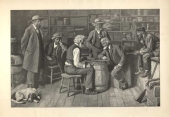The Checker Maven
The World's Most Widely Read Checkers and Draughts Publication
Bob Newell, Editor-in-Chief
Published every Saturday morning in Honolulu, Hawai`i
Noticing missing images? An explanation is here.
The Masked Man Rides Again
We thought we were done with our Masked Man series, but we came across something just too good to pass up. Here's a photo of the subject of this article:

Now for the situation:
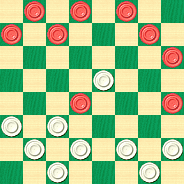
WHITE
White to Play and Win
W:W15,21,22,25,26,27,28,30,32:B1,2,3,5,6,8,12,18,20.
Our Hero's opponent made an egregious blunder a couple of moves back. The position in the diagram arose after a couple of forced trades. In the actual match, said Hero missed the win. Can you succeed where he did not? And while you're at it, can you name the man in the photo? How about his opponent? How about the year and location of the match, and the results?
We're asking a lot, so we won't tease you any further. After you've given this your best shot, click on Read More to see the solution, an animation of the complete game, and the answers to all of our questions.![]()
CheckerBoard 1.64: All We Can Say Is "Wow"!
Martin Fierz recently released a new, major upgrade to his CheckerBoard interface, and it's a gem.
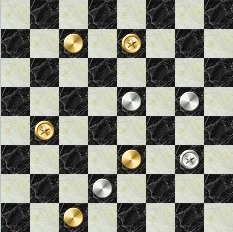
This new release features improvements in appearance, options, and analysis. If you haven't yet upgraded, you should do so at once: visit Martin's blog for a download link and installation instructions.
Now, this new gem does have a couple of rough edges related to installation. We didn't succeed with an in situ upgrade, and ended up doing a new installation to a new directory, necessitating copying our databases from the old directory to the new. Not a big deal, but you might save yourself some frustration and just go with a new install.
You also need to be certain that your engines (e.g., KingsRow) are compatible with this latest release, and that they are placed in the new 'engines' subdirectory. Ed Gilbert has released KingsRow 1.15q, fully compatible with CheckerBoard 1.64; there is a link on Martin's site. Be sure to upgrade!
But believe us when we say that these minor extra troubles are worth it.
The new CheckerBoard gives you a choice of languages: English, Spanish, German, and Italian are currently available (though surprisingly, not French). There is also a choice of board and piece images (developed and contributed by Ron Carney). No longer must you bear with the flat circles of previous versions; now you have a choice of an elegant 'official' set or a stunning metal and marble set (the old circle set is still there if you really can't bear to part with it). Click here for screenshots; to preserve detail these are rather large and we've put them on a separate page.
Game database (PDN) options are improved, and there is now the possibility of analyzing a complete multi-game PDN file in one single "batch" run. (Depending on your computer and the size of the file, this could occupy your machine for hours or days!)
There have been some meaningful technical improvements; at least subjectively, it seems that the large endgame databases load faster, and information provided by the program as to what it's doing is now more complete and useful. The overall "feel" of the program is snappy and quite pleasant.
There is also a sound option that we haven't been able to make work as yet, though we assume this provides audio feedback for piece moves.
In this release, Martin has done a fine job of balancing utilitarian features, performance improvements, and aesthetics, without going down the insidious path of bloatware and useless chrome. CheckerBoard is easily overall the finest interface available today, with a superb choice of world-class playing engines to support it. Upgrade now if you have an older version; or if you haven't yet discovered CheckerBoard, there's no time like the present.![]()
A Little More Practical, Well, Maybe

Our stroke problems, we like to think, have been challenging, elegant, and charming (if we do say so ourselves), but they have had a certain artificiality in their makeup. So, for a bit of a change, we'd like to present you with one that may be of a somewhat more practical nature. At least, maybe. Or maybe not?
Here's the problem:
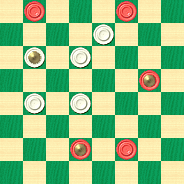
WHITE
White to Play and Win
W:W7,K9,10,17,18:B1,3,K16,K26,27.
The eminently practical solution can, as always, be viewed by clicking on Read More.![]()
Oldies But Goodies
Having completed republication of the introductory section to Willie Ryan's classic Tricks Traps & Shots of the Checkerboard, this month we swing into the main part of the book: a compendium of situations both famous and not-so-famous. Today, we present two classics which you've most probably seen before. If so, you'll have no trouble solving them.... right?
Here's Willie in his own words.
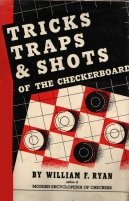
Don Canalejas' Cannonball
Almost 300 years ago, a Spanish mathematician, Don Canalejas, pointed out the most famous of all booby traps, a five-move demoralizer. This is the first pitfall the student should learn to avoid. Set the pieces up for play. Then move 11-16, 23-18, 16-20, 24-19, 8-11---A, forming the position on the adjoining diagram.
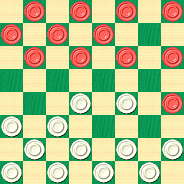
WHITE
White to Play and Win
W:W18,19,21,22,25,26,27,28,29,30,31,32:B1,2,3,4,5,6,7,9,10,11,12,20.
The Fool's Trap
Another premature opening procedure, which frequently embarrasses the beginner before he gets half started, is the Fool's Trap, another five-move paralyzer second in importance to Canalejas' Stroke. Set the pieces up for play. Then move 10-15, 23-19, 6-10, 22-17, 11-16---A, and we arrive at the situation shown in the diagram.
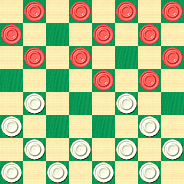
WHITE
White to Play and Win
W:W17,19,21,24,25,26,27,28,29,30,31,32:B1,2,3,4,5,7,8,9,10,12,15,16.
In each problem, find the winning move for White, and correct Black's play at A. Click on Read More to check your solutions.![]()
The Draughtsberg Project

The Checker Maven is announcing what we call The Draughtsberg Project, modeled a bit after the Gutenberg Project, which is an ambitious attempt to create an electronic library of all the classic works of literature.
Our project, already begun, is an effort to bring back checker books in electronic form. The sad situation today is that at most there are a dozen or so books about Anglo-American checkers in print; everything else has to be obtained hit-or-miss on the used book market, at whatever may be the cost. Public libraries generally have very little in their collections. It is a difficult situation for an up-and-coming checker player, or for anyone with any interest at all in checker literature.
We propose, over a rather extended period of time, to issue newly typeset electronic editions of important checker works that have passed into the public domain, as well as others still under copyright for which proper permissions can be obtained.
We have set ourselves the lofty goal of providing a high-quality, no-cost checker library that can be used for generations to come.
For more detail, including a proposed list of essential books and an invitation to participate, please click on Read More.![]()
Checker School: Coming From Behind, Part 3

The final installment of our three-part lesson on man-down draws is a triplet. In the first two settings we'll see more ways to come from behind, while in the third setting, alas, we won't be able to pull it off.... but from this we'll learn what to try to avoid.
Ever been a man down in an endgame? Not you, right? As we've said in the other lessons in this series, it happens to everyone. Saving the draw, when possible, is an important skill to master. If you're a student, study this lesson carefully. If you're an advanced player, a review of what we take to be "obvious" can never hurt!
Let's start out with this position:
WHITE
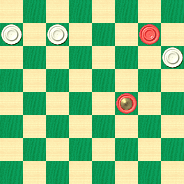
BLACK
Black to Play and Draw
Next, the famous Payne's Double Corner Draw, which should be learned by everyone who ever touches a checkerboard:
WHITE
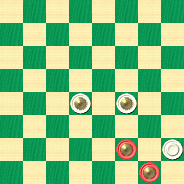
BLACK
Black to Play and Draw
And finally, a lost opportunity, to be contrasted with the very similar-looking Payne's Double Corner Draw:
WHITE
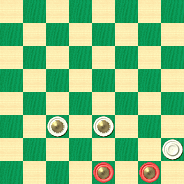
BLACK
Either to Play, White Wins
Take your time working these out, and then click on Read More for solutions, a sample game, supplementary problems, additional examples, and a host of detailed explanatory notes.![]()
The Simple Life

This past holiday season was filled with the usual hustle and bustle, and often stress triumphed over enjoyment. Many of us are a bit relieved, in fact, to return to the simpler, more ordinary days of the year.
Here's a Tom Wiswell problem, then, that seems to promise us the joy of simplicity.
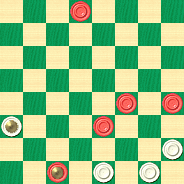
WHITE
White to Play and Draw
W:WK21,28,31,32:B2,19,20,23,K30.
White is a man down but regaining it is child's play. Has the simple life arrived, and have we solved a Wiswell problem in mere seconds?
Alas, life is not easy, and neither is this problem. Can you, without too much stress, see through to the solution, and bask in contented post-holiday enjoyment?
Don't fret. You can always click on Read More to check your answers.![]()
The New Year Rushes In

Click on a problem to display it; when you're done, click on Read More to check your solutions.
But above all, enjoy the New Year and keep on reading the weekly editions of The Checker Maven!
New Year's Eve Speedster No. 1
New Year's Eve Speedster No. 2
![]()
A Holiday Puzzler

Whatever holidays you celebrate, The Checker Maven wishes you the best of the season and hopes you enjoy this special challenger, our holiday gift to you.
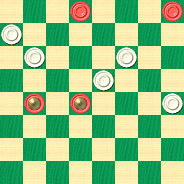
White
White to Play and Draw
W:W5,9,11,15,20:B2,4,K17,K18.
White may be a man up, but Black has two kings and a strong position. Can you provide some holiday cheer for the White side?
In the spirit of giving, here's a hint: the natural-looking 5-1 loses. Can you tell why?
Click on Read More to unwrap the solution.![]()
Pretty Complex, But ....

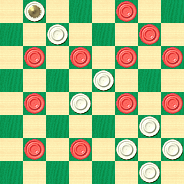
WHITE
White to Play and Win
Can you make waves with your solution, or will quantum indeterminacy hide the answer? After you've tried out the problem, click on Read More to find out.![]()
The Checker Maven is produced at editorial offices in Honolulu, Hawai`i, as a completely non-commercial public service from which no income is obtained or sought. Original material is Copyright © 2004-2026 Avi Gobbler Publishing. Other material is public domain, AI generated, as attributed, or licensed under CC1, CC2, CC3 or CC4. Information presented on this site is offered as-is, at no cost, and bears no express or implied warranty as to accuracy or usability. You agree that you use such information entirely at your own risk. No liabilities of any kind under any legal theory whatsoever are accepted. The Checker Maven is dedicated to the memory of Mr. Bob Newell, Sr.

